
www.haemophilia.org.au World Hepatitis Day How do you keep your liver healthy? Stories and tips Haemophilia: men and babies
FAQs for men with haemophilia Travel Jack shares his story HAEMOPHILIA F O UND ATION AUSTRALIA Number 223 SEPTEMBER 2023
Inheritance
Registered No.: A0012245M

ABN: 89 443 537 189 Street address: 7 Dene Avenue Malvern East, Victoria, Australia 3145 Postal address: PO Box 1208, Darling, Victoria, Australia 3145 Tel: +61 3 9885 7800 Freecall: 1800 807 173 Fax: +61 3 9885 1800 hfaust@haemophilia.org.au www.haemophilia.org.au
Editor: Suzanne O’Callaghan
Read National Haemophilia online https://www.haemophilia.org.au/ nationalhaemophilia:
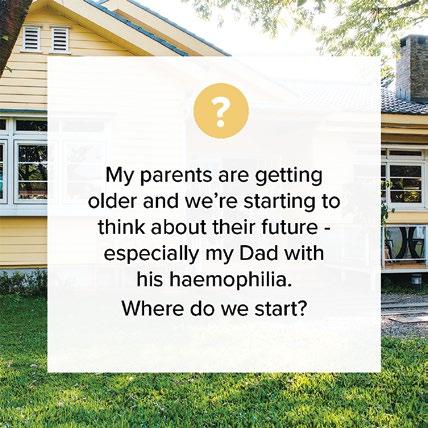
2
Haemophilia Foundation Australia
HAEMOPHILIA F O UND ATION AUSTRALIA CONTENTS 3 From the President 4 Bleeding Disorders Awareness Month 5 PROBE Australia Study 6 World Hepatitis Day 8 Finally cured of hep C: Alex’s story 11 WFH Shared DecisionMaking Tool 12 Congenital fibrinogen disorders 14 Emicizumab in haemophilia A 15 Haemophilia: Men and babies 20 Mouth bleeds 23 Youth News: Jack’s travel story Find out more at: https://tinyurl.com/GOH-Aged-care Navigating the different Aged Care services can be confusing. In the new HFA Getting Older Hub section on Aged Care services and homes, we walk through types of services and care, special issues for people with bleeding disorders and link you to more information.
Gavin Finkelstein President, Haemophilia Foundation Australia

AUSTRALIAN CONFERENCE
As we prepare this September issue of National Haemophilia, HFA staff and the Program Committee are also finalising the program and logistics for the national Conference. Conference registrations have been strong, and I hope I will be reporting a very successful Conference in the December issue along with some reports of sessions that might interest people who were not able to attend.
Strong sponsorship and support for the Conference meant we could go ahead with it despite uncertainty around our government funding. HFA Council determined the Conference remains a very important stakeholder meeting and we took steps to make sure it was focused on community needs. I am pleased the Conference budget was also able to offer some financial support to help some delegates from different parts of Australia to attend.
The Conference theme of Working together, improving outcomes was chosen because we are at a point in the evolution of treatments where a range of options are needed so they can be tailored to the needs of individuals - no longer is it a case of ‘one treatment fits all’. The Conference will have served as a forum for discussing directions and strategies for the future and I welcome your opinions and experiences.
From the President
HFA FUNDING
We remain optimistic that our advocacy to government and your direct support will have led to the reinstatement of Commonwealth government grants to HFA.
The uncertainty surrounding future government grants has made a difference to our current activities and ongoing sustainability. HFA is using reserves held for a different purpose to tide us over. HFA seeks government support to give it the capacity to continue to operate as a national peak body, provide advice about government policy from perspectives of people living with bleeding disorders and for some of its communications and health education. HFA is a key Information Partner around bleeding disorders with HealthDirect, which is funded by Australian governments to provide a national health information service to all Australians, and our evidence-based education resources and digital communications are critical for our community and our stakeholders.
At the time of writing this, I am pleased to report that we have had some productive discussions with government officials, the Minister for Health and Aged Care and Assistant Minister and look forward to a positive resolution.
3
National Haemophilia 223, Sept ember 2023
Once again in October 2023 we will have a whole month to raise awareness about bleeding disorders.

EVENTS AROUND AUSTRALIA
VIC - www.hfv.org.au
28 October - HFV Walk, Albert Park
NSW - www.hfnsw.org.au
29 October - HFNSW Walk, Haberfield
QLD - www.hfq.org.au
3 October - Thank you GP reception at Government House
The 2023 theme for Bleeding Disorders Awareness Month is WORKING TOGETHER
Over the month we will highlight how working together is working as a community and with your health care team towards good health and wellbeing, including looking after your mental health.
We will also launch Red Week from 22 October to 28 October 2023 – where you get a chance to do everything red!!
We will launch our calendar at the end of September. To be advised about events, register for our E-news: www.haemophilia.org.au/enews or keep an eye on our website and social media platforms.
PROMOTIONAL ITEMS
Orders for promotional items are now open. These items are free of charge. Order them to use for your school, workplace or family/friend event. We have balloons, pens, notepads, colouring-in sheets, information posters and lots more.
Put your order in at: www.haemophilia.org.au/BDAMorder
7 October - Bunnings Sausage Sizzle, Rothwell
21 October - Memorial Plaque unveilingJeays Street Park, Bowen Hills
WA - www.hfwa.org
7 October – Bunnings Sausage Sizzle, Subiaco
HOW CAN YOU BE PART OF THE WEEK?
• Order promotional items for your event, information stalls and your child’s school/childcare
• Run a fundraising event
• Host a Red event, e.g. Red Cake Day, Red Dress up Day
• Share information on your social networks
• Children and their friends can take part in the colouring-in competition or a Scavenger Hunt
• Take part in HFA and Foundation activities (Calendar coming soon) For
Contact: Natashia Coco
M: 0403 538 109
E: ncoco@haemophilia.org.au
4 National Haemophilia 223, Sept ember 2023
more information
the Bleeding Disorders Awareness Month section at www.haemophilia.org.au/BDAM
Visit
PROBE Australia Study
The 2023 round of the PROBE Australia Study has now commenced!
WHY IS THE PROBE STUDY IMPORTANT?
What is the impact of haemophilia on Australians? What has changed since new treatments became available? How can we provide high quality evidence about this?
With more new treatments becoming available, HFA’s advocacy will rely on strong and credible data.
We also need good evidence to understand the different experiences of living with haemophilia – for example, women, people with mild haemophilia or inhibitors, getting older with haemophilia.
You may have done the PROBE survey in 2019. This is a new round of the survey.
The 2023 round will compare results now to 2019, which was before new treatments were widely available in Australia.
WHAT IS PROBE?
PROBE (Patient Reported Outcomes Burdens and Experiences) is a multi-national and well-respected research study (www.probestudy.org) which allows people with haemophilia to report their haemophilia severity, treatment history and the impact of haemophilia on their daily life. It compares their answers to other people in their community who do not have a bleeding disorder.

HOW CAN YOU HELP?
You are invited to complete the questionnaire if you are an adult (18 years+) who lives in Australia and:
• have haemophilia or carry the gene OR
• do NOT have a bleeding disorder.
Consider passing the survey on to your partner/wife/ husband or other members of your family or interested friends or colleagues. We need several hundred Australian participants for good quality results.
HOW TO DO THE SURVEY
The questionnaire is available:
• Web version at myprobe.org
• Or download the myPROBE app from Apple Store or Google Play (Android)
• Or ask your local Foundation or HFA for a print survey pack
Choose Country-Australia and Language-English and CONTINUE
The web and app survey automatically saves your responses as you go. You can come back later and keep going from where you left off.
WHAT HAPPENS TO YOUR DATA?
All responses are anonymous and confidential. They are combined for statistical data and will not identify individuals. The survey is voluntary – completely up to you. Statistics from Australians survey responses are provided to HFA by the international PROBE team to use in our advocacy and planning for the future. You may have seen the 2019 data in the HFA Getting Older report.
MORE INFORMATION
For more information about the PROBE Australia study, visit: www.haemophilia.org.au/research
Or contact Suzanne at HFA:
E: socallaghan@haemophilia.org.au
T: 1800 807 173
5 National Haemophilia 223, Sept ember 2023
World Hepatitis Day 2023
World Hepatitis Day is marked globally on 28 July. This is part of a worldwide campaign to see an end to viral hepatitis. In 2023 the theme is hep can’t wait, reminding us that hepatitis C remains an important issue for our community and that acting now is vital. This year landmarks around Australia glowed green on World Hepatitis Day to raise awareness about the campaign.
Hepatitis C has had a profound effect on our community. In Australia many people with bleeding disorders acquired hepatitis C from their plasmaderived clotting factor treatment products or other blood products before 1993. Several safety measures were introduced by 1993 and the risk of bloodborne viruses from plasma-derived clotting factor products in Australia is now considered to be extremely low. But many people in our community live on with the consequences of those early infections.
As a Partner in the national World Hepatitis Day Campaign, HFA works with Hepatitis Australia and the state and territory Haemophilia Foundations on the annual Australian awareness campaign and is committed to making a difference on hepatitis C in Australia.

TAKING ACTION
Current hep C treatments are radically different to the early interferon treatments. They are now a once-daily tablet, with few if any side-effects and very high cure rates. Many Australians with bleeding disorders and hepatitis C have now had treatment and been cured –but some need ongoing care for their liver health.
Were you cured? Has your liver recovered?
It’s a temptation to put your liver health out of your mind once you are cured. But if you don’t know what your liver test results were when you were cured, don’t wait to find out. Take the time to contact your hepatitis doctor or your GP and ask them.
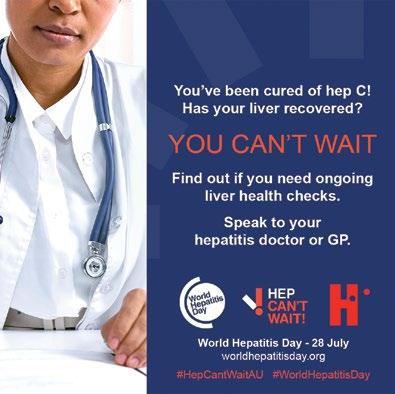
REMEMBER
If you had cirrhosis or extensive scarring before being treated and cured of hep C, you will still need to have a liver ultrasound scan every 6 months long-term.
6 National Haemophilia 223, Sept ember 2023
Sadly, some people with bleeding disorders and hep C have very advanced liver disease caused by long term infection. Close liaison between hepatitis or liver specialists and Haemophilia Treatment Centres is very important for care and treatment. Research into management of advanced liver disease is ongoing.
5 WAYS TO KEEP YOUR LIVER HEALTHY
PERSONAL STORIES
We are grateful to Alex and Jake for sharing their experiences with hep C – being cured and caring for their liver health. You can read Alex’s story in this issue of National Haemophilia. Jake’s story is available on the HFA website at https://tinyurl.com/hepC-jake
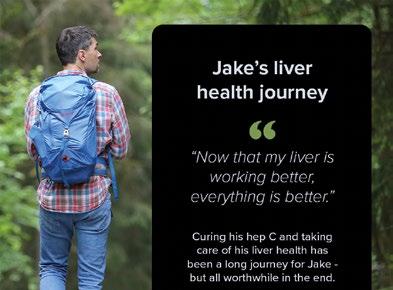
A healthy liver is important to us all. Your liver has a lot of different jobs to do to keep your body working well.
These are some tips from our hepatitis specialists to keep your liver in good shape.
1 2 3 4 5
Have a balanced diet
WHO IS AT RISK?
For some women and men with mild haemophilia and VWD, who perhaps only had one or two treatments in their lifetime, it has been a surprise to find out they were exposed to hepatitis C.
If you ever had a blood product before 1993, including blood transfusions and plasma-derived clotting factor concentrates, you could be at risk of hepatitis C
Stay active and maintain a healthy weight
Avoid or minimise alcohol intake
Take care of your mental health and wellbeing
Ask your doctor if you need liver health monitoring.
You may have been wondering about testing and not got around to it yet. But now is the time to talk to your doctor about a hep C test - and have treatment to be cured, if you do have hep C! Hep C tests are simple blood tests.
FOR MORE INFORMATION
Visit:
• www.world.hepatitisday.org.au
• The HFA World Hepatitis Day page: www.haemophilia.org.au/world-hep-day
7 National Haemophilia 223, Sept ember 2023
Illustrations from Freepik
Finally cured of hep C Alex’s story
What is it like to be cured of hepatitis C after decades of living with the virus? Alex spoke with HFA about his hep C journey – and shares his tips for liver health.

Alex has von Willebrand disease (VWD), a bleeding disorder which requires specialised treatment to manage bleeding with injury or surgery. He acquired hepatitis C as a boy when he had a tonsillectomy and was treated with cryoprecipitate to prevent bleeding. Cryoprecipitate is made from the plasma part of human blood. In the 1980s many people with bleeding disorders were exposed to hepatitis C virus (HCV) through their treatments with blood products and plasma-derived clotting factor concentrates. By 1993 increased safety measures had been introduced in Australia: new tests to screen for HIV and HCV in the blood supply and viral inactivation manufacturing processes for bleeding disorder treatment products.
GROWING UP WITH HEP C
Alex was advised he had hepatitis C when he was still a schoolboy.
‘This was all during the time when HIV and the Grim Reaper was a big thing. I felt a huge sense of shame and didn’t tell a single soul. My family knew but we didn’t really talk about it.’
Having VWD, nosebleeds and cuts which would bleed a lot made him very anxious about transmission – at home with his family, with his friends and in his workplace. Added to that were the symptoms of hep C, which made managing work challenging.
8 National Haemophilia 223, Sept ember 2023
is not his real name
*Alex
‘I felt like I had won a million dollars.’
‘Some of the symptoms of the virus were lethargy and fatigue. At times I was between jobs and it was really hard dealing with Centrelink. In one job I had to handle food. I was paranoid about cutting myself and putting blood in the food and stressed about my co-workers knowing my status. I had to be careful not to cut myself and if I did, I had to make sure no one helped me.’
EARLY TREATMENTS
Alex undertook treatment for his hep C several times. He had the early interferon-based treatments twice, in 1993 and 2008, and neither were successful. These treatments were well-known for severe side effects, including psychiatric problems, and had a heavy toll on his mental health and his relationships – in both cases he broke up with long-term girlfriends at the time.
‘The interferon was really difficult - it was bad, just wretched. I was really unwell mentally and the treatment wasn’t working. With the first treatment I lasted less than 8 weeks. With the next treatment in 2008, I did about half of the treatment course, around 3 months.’

A CURE
‘When the new treatments became available in 2016, I was one of the first in line. The new treatments are completely different – just pills, no injections. No side-effects. Just boring really, but so successful!’
‘I was cleared of the virus in 6 weeks. I was prepped for the usual trauma of treatment, but after 6 weeks of treatment they said you can stop taking the drugs because you don’t have the virus anymore. I was cured.’
‘I had another fibroscan, did some more follow-up with the liver clinic for two years and the tests showed my liver was repairing itself. The liver clinic told me I didn’t need any further follow-up – I was fine.’
‘The new treatment was a godsend – I felt like I had won a million dollars.’
‘After I was cleared, my career took off. I started getting work. I stopped getting sick all the time. Now I don’t have a chronic illness, a ‘death sentence’ – I have a future. I thought about having hep C every day for 30 years. Not having to think about having infected blood and having the weight of that removed – amazing! It’s weird!’ >>
9 National Haemophilia 223, Sept ember 2023
LIVER HEALTH TIPS
Before he was cured, Alex gave up drinking alcohol to optimise his liver health.
‘I was having regular appointments and fibroscans with the hep C clinic and I only ever had moderate scarring. I stopped drinking altogether for a decade. The improvement in my liver function was really noticeable.’
‘With alcohol the social expectation was the hardest. It was all or nothing for me. But after 10 years I saved enough cash for a deposit on a house!’
His tips for reducing alcohol intake?
• Have an excuse for not drinking or drinking light beer – be the designated driver

• I would say no, I don’t drink when people pressed me. And if I implied I had problems with alcohol, people would back off really quickly and say, yeah, I get it, no worries, mate.
• People often don’t question you if you already have a drink.
• Having a drink of anything in my hand – a soft drink or a water – meant I wouldn’t need a drink because I had a drink.
• Ask for a dry ginger ale or a coke in a whisky glass and it looks like a scotch or a scotch and coke.
• A dry ginger ale in a pot glass with a few sips taken looks like a beer.
And now?
‘I could probably improve my diet and drink less alcohol but I exercise quite a lot. I stopped smoking – less to worry about. I do have regular blood tests with my doctor and my liver function tests are all totally fine. My health has improved generally –I barely get sick anymore.’
HIS MESSAGE TO OTHERS
‘If you have had hep C, you’re not alone. It’s a medical condition. It’s OK to not speak about it, but just so you know, you are surrounded by plenty of other people not speaking about it.’
‘Being clear of the virus is quite amazing.’
‘So reduce your alcohol intake, get treated and love yourself. It doesn’t matter how you got it – you are not your virus. You are a beautiful soul.’
10 National Haemophilia 223, Sept ember 2023 >>
WFH Shared Decision-Making Tool
Suzanne O’Callaghan
In these times of new therapies, how does the global bleeding disorders community best approach treatment and care?
The World Federation of Haemophilia (WFH) 2023 Global Policy and Advocacy Summit was conducted virtually in July 2023 and was a great opportunity to reflect on some of the issues from an international perspective.
Plenary: Shared decision-making model in healthcare
Chair ~ Courtney Thornburg, Medical Director, Hemophilia and Thrombosis Treatment Center at Rady Children’s Hospital, San Diego, USA
Speakers: Mark Skinner, WFH Executive Committee; President, WFH USA; Donna Coffin, WFH, Canada; Victor Jiménez-Yuste, HTC Director, Spain; Bradley Rayner, GNMO, South Africa
With the variety of new haemophilia therapies now available and coming to market, people with haemophilia need to consider their treatment options carefully and understand what is right for them. Informed decision-making is crucial to this.
The Summit provided a platform to launch the new WFH
Shared Decision-Making tool for hemophilia
Mark Skinner explained the Shared Decision Making (SDM) process, where clinicians and people with haemophilia work together to make decisions about treatment.
This process is patient-centred and helps them to personalise the decision-making to the individual: taking into account both the clinical outcomes that are likely, such as reduced number of bleeds, and also the patient’s personal goals, such as no limits on work, school, family life. This process would repeated at times over the patient’s lifetime and as their treatment choices and life goals evolve. It is also a process that makes the patient a full partner in their healthcare team.
What is the Shared Decision Making process?
• A patient shares with a clinician all their aspirations, relevant preferences, values and goals
• A clinician shares with a patient all relevant information and best scientific evidence available on all the pros and cons of all potential treatment options
• With this mutual understanding, the patient and the clinician decide the best course of action.
The WFH Shared Decision-Making Tool is an interactive aid for decision-making designed to facilitate discussions about treatment options between people with haemophilia and or parents/carers and their healthcare team. It is intended for discussions about prophylaxis treatment and takes a step-by-step approach to questions such as:
• What are my goals? How is my current treatment limiting my goals?
• What are my treatment options? What are the benefits and risks, potential side effects?
• Who else do I want to talk to about the treatment options?

• Who else do I want involved in my decision?
The tool includes information about a range of haemophilia treatments available and innovative interactive tables for patients to compare their options, including lifestyle impact. The patient can write their reflections, preferences and questions in the online tool and download a PDF of their personalized summary to help the discussion with their healthcare team.
The Tool is available on the WFH website – www.wfh.org
Suzanne O’Callaghan is HFA Policy Research and Education Manager
11 National Haemophilia 223, Sept ember 2023
Congenital fibrinogen disorders
Dr Radha Ramanan received the AHCDO John Lloyd Clinical Excellence Grant in 2022 for her research project titled Phenotypic characterisation and molecular profiling of congenital fibrinogen disorders: the Australian experience. This is an update on her project.
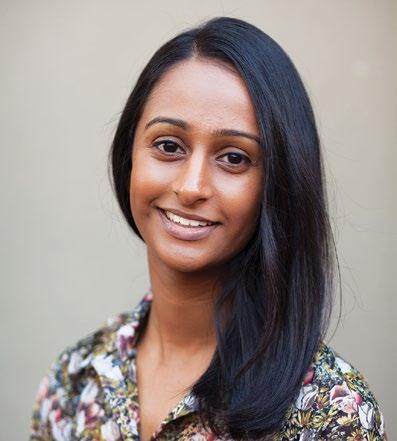
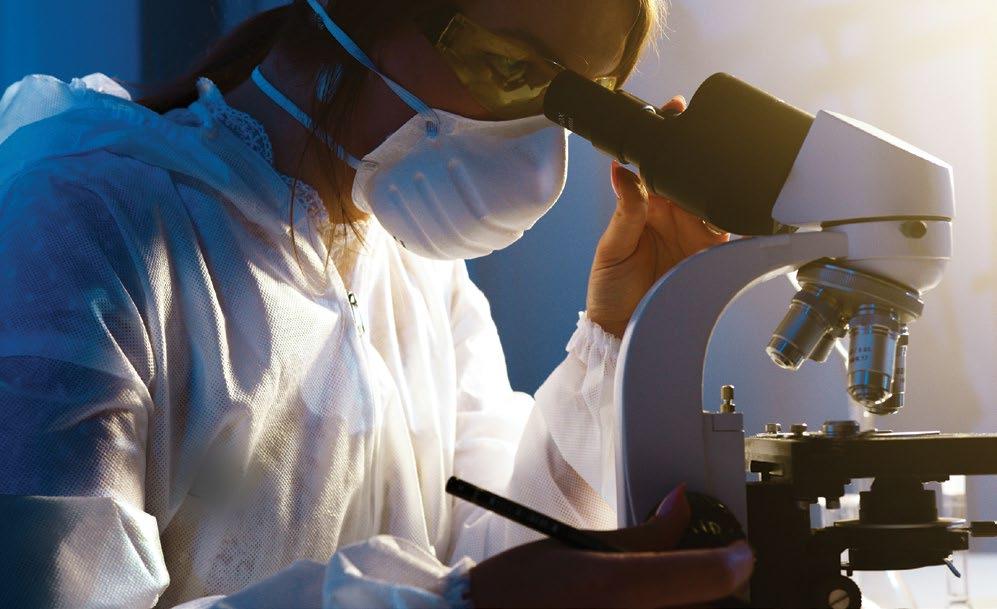
Fibrinogen acts as an important clotting factor required for adequate blood clotting and wound healing. Currently, 160-170 patients with a congenital fibrinogen disorder nationwide are included on the Australian Bleeding Disorders Registry (ABDR).
These patients have varying symptoms from their fibrinogen disorder: some patients have a bleeding problem, others develop blood clots (thrombosis) and many patients have no issues related to the fibrinogen at all. This project involves collecting data on the clinical manifestations of patients with a congenital fibrinogen disorder identified through the ABDR, including bleeding episodes, thrombotic episodes and outcomes in the surgical and obstetric settings.
Additionally, genetic testing will be performed in these patients. Recurrent mutations in the FGA, FGB and FGG genes (these are the genes which encode for the fibrinogen protein) have been welldescribed internationally, however genetic testing of the Australian population of this cohort has not been performed to date. We aim to not only assess the FGA, FGB and FGG genes in this cohort, but also to examine approximately 90 other genes to identify if there may be other genetic ‘modifiers’ that may explain some of the variation in this cohort, for example, co-existing thrombosis-predisposing mutations that may be present in congenital fibrinogen disorder patients with a thrombotic phenotype.
12 National Haemophilia 223, Sept ember 2023
Radha Ramanan
Dr Radha Ramanan
We are also collecting blood samples that are being stored for future laboratory studies investigating the structure and function of the abnormal fibrinogen protein.
We will also analyse the treatment approaches used in patients with a congenital fibrinogen disorder in the acute bleeding, peri-operative and obstetric settings, and anticoagulation (ie blood thinning) approaches used in those patients presenting with thrombosis. Robust evidence-based guidelines for management of these patients are lacking, and typically plasmaderived replacement (eg fresh frozen plasma, cryoprecipitate, fibrinogen concentrate) is used with varying success. We aim to assess outcomes associated with the various treatment modalities to inform national guidelines for management in this complex group of patients.
We have presented some of the preliminary clinical data of the Alfred Health patients with a congenital fibrinogen disorder at the Australian Blood conference in 2022. The Alfred Health cohort constitutes 26% (44/167) of all Australian patients with a congenital fibrinogen disorder:
• <5 afibrinogenemia
• 16 hypofibrinogenemia
• 25 dysfibrinogenemia
• <5 hypodysfibrinogenemia
• <5 not classified.
At presentation, the research study patients with a congenital fibrinogen disorder were diagnosed by:
• 30% (13/44) from an incidentally discovered low fibrinogen
• 20% (9/44) from familial screening due to an affected family member
• 41% (18/44) due to a bleeding event
• <5 due to a thrombotic event
• <5 through circumstances that were not specified.
Prior to diagnosis:
• thrombotic events had occurred in 11% (5/44)
• bleeding events had occurred in 33% (15/44)
• pregnancy loss in <5/44.
53 procedures were recorded: of these 19% (10/53) were major and 81% (43/53) were minor procedures. Plasma-derived fibrinogen concentrate (RiaSTAP®) was used in 42% (22/53). Peri-operative outcome data was available for 27/53 procedures: of these greater-than-expected bleeding occurred in 19% (5/27) and thrombosis in <5/27.
So far we have prospectively collected blood samples on 20 patients with a congenital fibrinogen disorder across Australia, to pair with the clinical data described above. The aim is to collect at least 50 patients in total. We hope to finish recruiting patients and collecting data by the end of 2024.
Dr Radha Ramanan is the current Australian Haemophilia Centre Directors’ Organisation (AHCDO) Research Fellow. Radha is also a Haematology Fellow at Alfred Health in Melbourne and is undertaking a PhD at Monash University, having completed her advanced training in clinical and laboratory haematology in 2021 at Alfred Health. She has an interest in bleeding disorders and molecular pathology and seeks to broaden our understanding of these fields through research funded by AHCDO.
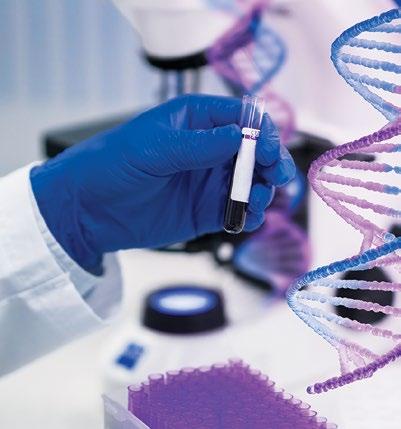
13 National Haemophilia 223, Sept ember 2023
Emicizumab in haemophilia A
Dr Radha Ramanan reports on one of her Australian Haemophilia Centre Directors’ Organisation (AHCDO) research projects.
Funded access to emicizumab prophylaxis for certain patients with haemophilia A was approved by the National Blood Authority in November 2020 through the governance of haemophilia treatment centres (HTCs). Emicizumab (Hemlibra®) is a nonfactor therapy for haemophilia A that is injected sub-cutaneously (under the skin). This project aims to assess the real-world outcome data since implementation and wide-spread use of funded emicizumab, collected through the Australian Bleeding Disorders Registry (ABDR).
BLEEDING RATE OUTCOMES
We have already collected the data on bleeding rates in patients with haemophilia A and are in the process of publishing this data as a scientific paper. The data was also recently presented in June 2023 at the International Society on Thrombosis and Haemostasis (ISTH) Congress in Montreal, Canada.1 In the overall population, we found that patients with haemophilia A have a reduced risk of bleeding since changing to emicizumab. The proportion of patients with zero bleeds increased from 54% to 64% after commencement of emicizumab. However, bleeding risk remained unchanged in adults and those on regular prophylaxis prior to emicizumab.

SURGERY OUTCOMES
Secondly, we aim to assess outcomes in the peri-operative setting in patients with haemophilia A who have switched to emicizumab therapy. The HAVEN-1 and 2 trials included patients undergoing
emergency surgery, however excluded those undergoing planned/elective surgical procedures. We have begun collecting this data and have data on 11 patients who have undergone 13 procedures so far. We will continue collecting data until the end of 2024. We will evaluate the laboratory measures of emicizumab if performed, rates of bleeding peri-operatively, adverse effects such as venous thromboembolic events and use of recombinant factor VIII or bypassing therapy in this setting. Preliminary data has been presented at the Australian Blood conference in 2022.
QUALITY OF LIFE OUTCOMES
Thirdly, we aim to collect data on quality of life in these patients using a validated questionnaire called the PROBE questionnaire. This will be sent out via email to participants.
REFERENCES
1. Ramanan R, Parikh S, MacFadyen JD, Tran H. Comparison of intraindividual bleeding outcomes pre- and post-emicizumab in Australian adults and children with haemophilia A with and without inhibitors: a nationwide real-world experience. Abstract PB0194. ISTH 2023 Congress, 24-28 June 2023, Montreal Canada. isth2023.eventscribe.net, accessed 7 August 2023.
Dr Radha Ramanan is the current Australian Haemophilia Centre Directors’ Organisation (AHCDO) Research Fellow.
14 National Haemophilia 223, Sept ember 2023
Radha Ramanan
Haemophilia: men and babies
Kara Cordiner, Penny McCarthy and Megan Walsh
When men with haemophilia call us at the Haemophilia Treatment Centre asking when to get their daughters tested to see if they carry the gene alteration for haemophilia, they are often surprised to hear that all their daughters are ‘haemophilia carriers’
HAEMOPHILIA IN THE FAMILY

While our male patients with haemophilia usually understand their condition and manage it well, they sometimes do not fully understand the
inheritance pattern in their family. Haemophilia genetics are complex and it can be challenging to appreciate the implications of heredity – that it is a multigenerational health condition that can affect your extended family, as well as family members close to you.
Haemophilia is often not a ‘dinner table’ discussion within the family, where inheritance and who is affected could be explored. As a result, family members can be unaware they are affected until an issue occurs.
A SNAPSHOT OF HAEMOPHILIA GENETICS Genes and haemophilia
Haemophilia is caused by a mutation or alteration in the gene making clotting factor VIII (8) or clotting factor IX (9).
In genetics:
• these genes are called the F8 gene and F9 gene
• all females with the gene alteration are referred to as ‘carriers’, because they ‘carry’ the gene alteration.
X and Y ‘sex’ chromosomes
The genes for making factor VIII (8) and IX (9) are located on the X chromosome. Everyone is born with ‘sex’ chromosomes. The X and Y sex chromosomes help to determine haemophilia inheritance patterns.
How do children inherit X and Y sex chromosomes from their parents?
• Individuals who are assigned ‘female’ at birth typically have two X chromosomes and receive one from each parent.
• Individuals who are assigned ‘male’ at birth typically have one X chromosome, which they receive from their mother, and one Y chromosome, which they receive from their father.
Haemophilia inheritance
Any male or female with an alteration in their F8 or F9 gene can pass it on to their children during reproduction, when X chromosomes are passed on from parent to child.
15 National Haemophilia 223, Sept ember 2023 >>
Male inheritance pattern
• If a male with haemophilia has children, he will pass his X chromosome onto all his daughters and they will inherit the gene alteration from him.
• None of his sons will have haemophilia - they receive their X chromosome from their mother, who is usually unaffected.
Female inheritance pattern
Females can carry the gene alteration causing haemophilia even if they don’t have symptoms.
A woman who carries the gene alteration can pass it on to both her sons and her daughters as all of her children will receive one of her X chromosomes.

It is helpful to remember that genetics does not have a memory. With each pregnancy:
• there is a 50% chance her male baby will have haemophilia
• and a 50% chance her female baby will be a carrier.
What about gender diversity?
This information explains the typical experience of genetic inheritance in haemophilia, but it can be more complex in some individuals. Gender affirming medical care after birth, eg hormones or surgery that some trans or gender diverse people may use to affirm their gender, will not change a person’s sex chromosomes or influence haemophilia inheritance patterns.
Their Haemophilia Treatment Centre can support gender diverse people with haemophilia with help to understand their individual bleeding and inheritance patterns and refer them to other genetic specialists, if appropriate.
16 National Haemophilia 223, Sept ember 2023
>>
When the father has haemophilia and the mother is unaffected.
FATHER MOTHER
has an X chromosome with the ‘haemophilia’ genetic alteration. has a unaltered X chromasome.

When the mother carries the gene alteration causing haemophilia and the father is unaffected.
None of the sons will have haemophilia. All of the daughters will carry the gene alteration. Some might have symptoms or have haemophilia.
TESTING CHILDREN
The most frequently asked questions we hear are:
• When do I get my daughter tested for the gene?
• Does she need her factor levels checked?
Our advice:
• Their daughter does not need to have a genetic test to know if she carries the ‘haemophilia’ gene alteration. Due to the X-linked inheritance pattern their daughters are all obligate carriers
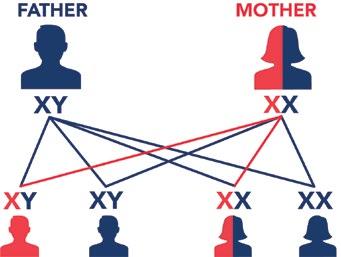
• It will be important for their daughter to consider genetic testing when she reaches childbearing years and before beginning family planning. This supports her and her partner to make informed
There is a 50% chance at each birth that a son will have haemophilia. There is a 50% chance at each birth that a daughter will carry the gene alteration. Some might have symptoms of haemophilia.
decisions and develop a birth plan specific to her and her child as genetic testing can take up to 6 months.
• If she is a baby, factor level testing can be deferred until she is a little older, before she starts her periods, unless she is exhibiting bleeding symptoms or requires surgery.
• Her factor levels will be influenced by hormones and her factor VIII (8), factor IX (9) and von Willebrand factor levels may increase with age.
17 National Haemophilia 223, Sept ember 2023 >>
XY XX XY XY XX XX
or or
Haemophilia genetic inheritence
Many men don’t know that their son will not be affected by haemophilia and their sons will not pass on the gene either.
Their daughters will always carry the gene alteration. Some may be asymptomatic with normal factor levels while others can have low factor levels and be considered to have mild haemophilia. Their father’s severity level does not determine their daughters’ levels and it is very rare for a female to have moderate or severe haemophilia.
Regardless of their own factor levels, daughters of men with haemophilia have a 50% chance of having a son with haemophilia and 50% chance of having a daughter that carries the ‘haemophilia’ gene alteration with each pregnancy.
WHAT IS AN OBLIGATE CARRIER?
Sometimes your inheritance pattern means you must have the gene alteration. In genetics this is called being an obligate carrier
Obligate haemophilia carriers include:
• ALL daughters of a man with haemophilia
• Mothers of one child with haemophilia, and who have at least one other family member with haemophilia
• Mothers of one child with haemophilia, and who have a family member who is a haemophilia carrier
• Mothers of two or more children with haemophilia.
WHAT TO CONSIDER
Parents are often confused about where to seek guidance and what to do if a man with haemophilia has a daughter.
When to test
There is usually no rush to perform factor level testing when she is a small child unless she is symptomatic or if there is a need for surgery. However, it is recommended that she has factor level testing before she starts menstruating (getting her period) in case she will need a treatment plan for managing heavy periods.
Identifying the family genetic mutation
If the family mutation is not known, fathers should consider having a genetic mutation test, which identifies the haemophilia genetic mutation in their family. This is valuable in several ways:

• It provides specific genetic information to support genetic testing in their daughters
• It supports their daughters and other haemophilia carriers in their family to make informed choices regarding future pregnancies and safe childbirth
• It enables identification of males with haemophilia and haemophilia carriers within their extended family.
It is helpful if females in the family understand if they are at risk of being haemophilia carriers. It is also important for them to know other information:
• The type and the severity of haemophilia in the family
• If their family gene mutation has been identified
• Who else in their family has haemophilia – not only their father or brothers, but uncles, cousins, etc, along with other females who are known haemophilia carriers.
Genetic testing is much quicker and easier if the family mutation is known. It can take many months to get a result with new genetic mutation testing. It is valuable for women to have had genetic testing and know their results before getting pregnant.
18 National Haemophilia 223, Sept ember 2023
>>
The importance of a family tree
Family trees are crucial for providing information for families when speaking about haemophilia and how it is passed on. As haemophilia is X -linked, it may affect many different branches of the family where there are many different surnames. We often find that someone in the family is the family tree keeper and their assistance is invaluable in identifying who is affected.
Informing daughters
If a man with haemophilia has daughters, it is important to speaking to them about being a carrier before they reach childbearing age.
As they grow up, this can involve making sure they understand what being a carrier means and making the information about haemophilia in the family accessible.
Information about the family gene mutation includes not only what it is, but who in the family has done the testing and through which Haemophilia Treatment Centre so that records can be accessed to match when daughters need to have genetic testing and/or are undertaking family planning.
Daughters also need to know they should share this information with their obstetrician. This information allows daughters to have a have safe pregnancy and their babies a safe delivery.
Many people find genetic testing gives them a lot to think about. Their local Haemophilia Treatment Centre will be able to support daughters and their partners in these discussions around haemophilia inheritance and testing: they may have genetic counsellors on site who are able to assist with these discussions or they can refer the daughter and her partner to external genetic counsellors. The Haemophilia Treatment Centre can also refer to other counselling services, if needed; or alternatively their daughter can seek a referral through her GP.

MORE INFORMATION
Speak to your Haemophilia Treatment Centre for more information on haemophilia inheritance and genetic testing.
Read more in Haemophilia testing in women and girls: a guide (Haemophilia Foundation Australia, 2023)
• Download from the HFA website: https://tinyurl.com/haemophilia-testing-simple
• Or ask HFA to send you a print copy
Email: hfaust@haemophlia.org.au
Kara Cordiner, Penny McCarthy and Megan Walsh are Clinical Nurse Consultants at the Ronald Sawers Haemophilia Centre, The Alfred hospital, Melbourne.
19 National Haemophilia 223, Sept ember 2023
Mouth bleeds in bleeding disorders
Grainne Dunne
Our mouth is a most wonderful and interesting part of our body. It’s the first step in breaking down food to allow us to then to swallow our food; we taste everything using our mouth; it’s important in the process of breathing; we communicate with our mouths to talk, smile, show emotions; and it’s an important way to show our loved ones how we care about them with that simple but important kiss. However, it’s also highly vascular.... which means it has many, many blood vessels that are needed to perform all the above amazing functions. When you have a bleeding disorder of any type (haemophilia, von Willebrand disease, inherited platelet function disorder or another rare bleeding disorder), injury to these blood vessels can lead to a lot of blood loss and at times can be challenging to stop.
SO WHY CAN MOUTH BLEEDS BE TRICKY TO STOP?
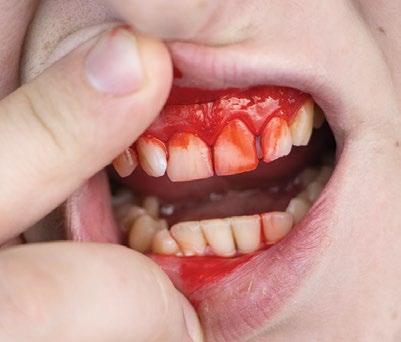
1 As this is a highly vascular area, there are a lot of blood vessels to leak out blood when injured.
2 Saliva in the mouth, required to break down food and to keep our mucus membranes becoming too dry, contains enzymes and uric acid. These elements are not good friends with a newly developing clot, particularly in a bleeding disorder when the clot is difficult to make to begin with. Saliva can play a part in breaking down a weak clot which leads to the initial injury site re-bleeding again.
3 Chewing and movement of food around the mouth, particularly hard or bulky foods, can knock at and disturb a developing clot and thus restart the initial bleed again.
4 Humans are curious by nature. When we feel something unusual in our mouth, we naturally want to investigate it. In fact, for many of us, it’s difficult to consciously leave it alone. So, whether consciously or subconsciously, we often push our tongue over the injury site to ‘examine/investigate’ that unusual feeling in our mouth. In some cases, it may be an over-curious finger that finds its way into our mouth investigating that tender injury siteespecially in children. Such ‘examination’ or ‘investigation’ can disturb a tender and developing clot and of course... restart the bleed.
5 Objects in the mouth: In young toddlers and babies, toys and other objects are notorious for finding their way into the mouth. A child at this age often uses their mouth to investigate an object – which is not what one wants when a clot is trying to form and harden after a bleed has recently occurred. The older and more mature child (and adult!) can accidently hit the injury site using their eating utensil e.g., fork, spoon, and again disturb the delicate clot development.
20 National Haemophilia 223, Sept ember 2023
FIRST AID FOR MOUTH BLEEDS
Ice! It’s simple but its effective.
• If ice is not available, try rinsing/gargling with very cold water.
• Icy poles can be offered to children as a friendly and co-operative form of ice. It also helps to extend the time for which ice can be kept in their mouth. It often acts as a calming soother too after an injury has occurred.

• You can apply pressure to the area with a gauze – however, this isn’t usually well received in children. An icy pole (or plain ice if tolerated) will be more effective!
When does a mouth bleed need medical help?
• When the bleed is continuous for longer than 15-30 minutes. Discuss this also with your local Haemophilia Treatment Centre. Sometimes this time plan may need an individualised approach.
• If the bleed can be stopped with first aid but restarts again and then continues to stop and start. If unsure what to do, call your local Haemophilia Treatment Centre for advice.
• If vomiting occurs. This usually means that too much blood has been swallowed (and hence lost), which has irritated the stomach to initiate vomiting.
Blood loss from the mouth can be difficult to measure, especially if it stops and starts over a period of hours or days. One can easily underestimate the total volume of blood lost and may later be surprised to discover a significant drop in the patient’s haemoglobin level i.e., what the body uses to carry oxygen around the body. In fact, some people have had their first hospital presentation and bleeding disorder diagnosis made with a history like this.... including a significantly low haemoglobin.
If you are unsure about mouth bleeding, please do not hesitate to contact your local Haemophilia Treatment Centre at the time.
Do I need to tell my haematologist that I am having mouth surgery?
YES!
• If you or your child require any surgery in the mouth, however small, contact your local Haemophilia Treatment Centre. This is necessary for both urgent and non-urgent procedures. It’s very possible that surgery will need to be performed with factor replacement therapy or FFP/ platelets and supervision by your haematology team.
• Inform your surgeon that you or your child have a bleeding disorder and that consultation with your haematologist is necessary in advance of any surgery.
• Inform your dentist if any dental surgery is required, e.g., dental extraction, cutting of the gum. Routine check-ups and teeth cleaning are generally safe without needing factor/FFP/platelets.
21 National Haemophilia 223, Sept ember 2023
>>
DENTAL HYGIENE
Prevention is always better than cure!
Dental plaque is a sticky, acidic film of bacteria and food debris on teeth, which everyone gets - it’s a normal process. However, a build-up of plaque is bad for your teeth and if not removed will form tartar. Plaque and tartar increase your risk for dental cavities, tooth decay, gum disease, reseeding gums, and other harmful dental problems, leading to tooth loss and then the need for dental surgery.
• Ensure you brush your teeth regularly at least twice a day, and floss.
• See your dentist 6-monthly for routine check-ups and cleaning. Cleaning removes plaque and tartar which consequently reduces the risk for cavities, gum disease and other harmful problems.
To help between dental visits, you can remove some tartar at home. Here are a few tips.
• Baking soda: add a teaspoon of baking soda to your usual toothpaste, brush as usual and rinse with lukewarm water afterwards. Repeat twice weekly.

• White vinegar mouth wash: add 2 teaspoons of white vinegar to ½ cup of water and ½ teaspoon salt. Stir well, then gargle and spit. Use twice daily to rinse your mouth.
• Over the counter antibacterial mouth wash.
FURTHER READING
Australian Haemophilia Centre Directors’ Organisation. A consensus statement on the dental treatment of patients with inherited bleeding disorders, July 2010. https://www. ahcdo.org.au/documents/item/14. Accessed 7 August 2023.
HealthDirect – Dental care. https://www.healthdirect.gov.au/dental-care
Grainne Dunne is Clinical Nurse Consultant, Haemophilia, at Sydney Children’s Hospital
22 National Haemophilia 223, Sept ember 2023 >>
My amazing travel adventure
Jack talked to HFA about travelling overseas and managing his haemophilia for some amazing trips!
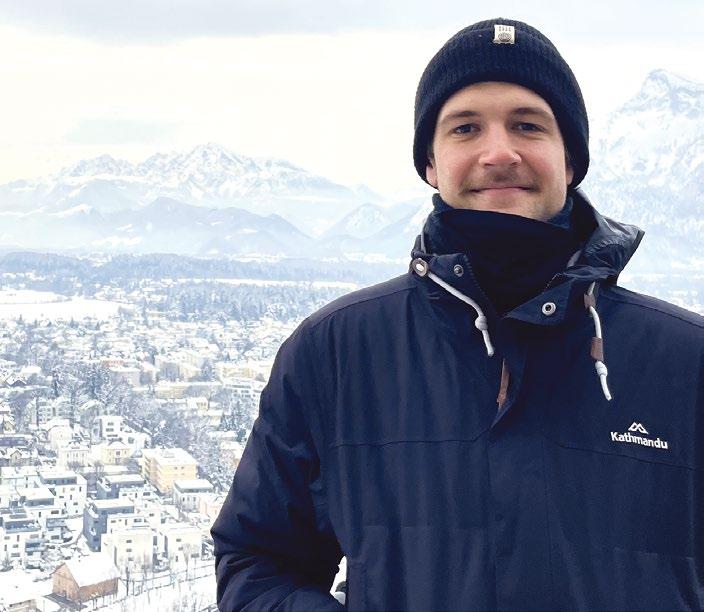

Where did you go on your trips?
I’ve done two separate trips over the last couple of years.
With my first trip, I went to Southeast Asia for about five weeks, mainly around the south of Vietnam and Thailand. I went with one of my best mates who I’ve known for years. We travelled at a pretty fast pace, moving to a different city every couple of days, about 14 different places across the five weeks.
With the most recent trip, I went to Europe for about 7 weeks with my girlfriend. I flew into England and started in London. My girlfriend’s family is from Wales, so I went across to Wales for a week or so.
Then we did a group tour, where we made some great friends and continued to travel with them following the tour. It was pretty similar to the earlier trip – we moved around really quickly and I went to about 12 countries. I started in England then went down through France, Switzerland, Spain, Monaco, Italy, Austria, Czech Republic, Germany, the Netherlands, Belgium and then back to London again, and then came home to Australia after that.
It was really exciting.
23 National Haemophilia 223, Sept ember 2023 >>
My name’s Jack. I am 22 years old and I have severe haemophilia A.
What were the highlights for you?
Some highlights of my trip to Asia were Dalat in Vietnam, a small town up in the mountains, which was really cool. I also loved Hoi An, with its old lanterns and unreal food - just an awesome vibe there.

Then in Thailand we did an island-hopping cruise around the Phi Phi Islands - amazing crystal-clear waters and reefs. I also loved another small island called Koh Tao, which is a tiny little speck on a map. It’s where a lot of people get their diving licence. It was just unreal beaches and scenery.

When we went to London, I got to go to an EPL (Premier League) game to watch the soccer, which was pretty sick. I also went to Printworks. I’m a DJ and I love my electronic music. Printworks is one of the biggest venues in the world, so going there was awesome. It’s actually closing down soon so it’s cool we caught that before it finished up.
And going skiing in Austria was just unbelievable. It was the middle of winter, so it was freezing. But we had some ‘bluebird days’ where it was perfect weather whilst we were on the slopes! It was my first time skiing. We just skied because in Austria there wasn’t a heap of snowboarding. But when I go to Canada later this year, I’m going to give snowboarding a crack and we’ll see how that goes.
24 National Haemophilia 223, Sept ember 2023
With my first trip, I went to the south of Vietnam and Thailand with one of my best mates who I’ve known for years.
I loved the small island called Koh Tao - just unreal beaches and scenery.
>>
How did you prepare to travel with your haemophilia treatment?
When I’m preparing to travel to another country, my first thing is to quickly check requirements in each country and make sure I am not bringing anything in that is illegal. It’s important to know, especially when we’re going to Asia or countries where they speak a different language. I get letters from the hospital to carry with me, so if I do ever get pulled up in customs, I have letters to explain why I’m carrying needles and treatment.
I usually have a meeting with my haemophilia nurse about eight weeks before I go away. We discuss a plan on how to tackle how much treatment I will need to bring to ensure they order enough treatment, as well as organise the doctors’ letters.
Then I make a plan of how to keep treatment cold, which is one of my biggest challenges. Not all hotels have fridges, so I come up with the worst-case scenarios, like a plan for keeping my treatment cold if I have a 12-hour travel day, or have a hotel that doesn’t have a fridge.

Then finally, I always make a list of where the Haemophilia Treatment Centres (HTCs) are, just in case of any emergency. That was a bit harder in Asia, because there weren’t as many HTCs. But in Europe there were plenty, so if anything did happen, I had an HTC where I could go and see some knowledgeable doctors.
How did you manage your haemophilia while you were travelling?
I had two different experiences of managing my haemophilia when I was traveling.
During my first trip I was using factor VIII (8) products, which required far more frequent treatments. After discussions with my haemophilia nurse and doctor, I was having one treatment per day when I went to Asia. This meant I had 35 doses, which was a challenge to carry that amount of factor VIII over there.

25 National Haemophilia 223, Sept ember 2023
Printworks in London is one of the biggest venues in the world, so going there was awesome.
>> Jack’s Story
In Austria it was freezing. But we had some ‘bluebird days’ where it was perfect weather whilst we were on the slopes!
But the biggest challenge is temperature, especially in a hot climate like Asia, and keeping that much treatment product cold for that long.
What was easier than you expected?
I’ve always had some form of anxiety that I would be pulled over and questioned why I have all these needles and syringes in my carry-on luggage, but I’ve never been stopped at customs either in Asia or in Europe. Which is nice!
Did you need to do anything special in the group tour?
There were a few extra considerations with the group tour. The main thing was discussing my condition with the tour manager so he was across it, in case of any emergency. There were also quite long bus rides. I discussed it with my tour manager and he allowed me to use the fridge on the bus to keep my treatment cold as well. But aside from that, I found as long as I was transparent and up front with the tour manager so he was aware of the health condition I had, it was no drama, really.
Apart from the tour managers, haemophilia is something I’ve normally kept to myself on my trips because I think as long as you manage it correctly, it shouldn’t affect the way you live. Obviously, my girlfriend was across it and when I travelled with my friend, he was across it, so they’re aware in case anything happened on the trip. But aside from that, I never really told other people.
Will you do anything differently on your next trip?

My next trip will involve skiing in Canada, so there’s probably going to be a bit more risk if I fell off a snowboard or something like that. Now that I am on non-factor therapy, that might mean carrying some extra factor VIII with me, just in case I did have a fall so that I have a bit of factor VIII to manage a bleed. But I’ll discuss that with my haemophilia team when I am closer to the trip.
It was a stark comparison to my second trip where I was using a non-factor product. I only needed to bring 3 treatments with me, which was much easier to keep cold, plus it was winter, so it was a completely different scenario.
I also needed to make sure I had correct travel insurance that included haemophilia, so that in case of any emergency, I would be covered overseas.
26 National Haemophilia 223, Sept ember 2023 >>
The biggest challenge is temperature, especially in a hot climate like Asia, and keeping that much treatment product cold for that long.
What travel tips do you have for other young people with bleeding disorders?


My main travel tip is to plan for every scenario and discuss this with your haemophilia nurses and doctors. I suppose the biggest concern with going away is you are a long way from home. If your parents are anything like mine, they will be extremely worried!
So have a plan to make sure you’re never going to be stuck, you’re always safe, you always have treatment with you and just be across everything you need to be so you can go on your trip with confidence and travel freely.
Read more
Want to know more about travel?
Visit the Travel section on the HFA website: https://tinyurl.com/HFA-travel
Check out the personal stories from other young people with bleeding disorders on:
• Factored In, the HFA youth websitewww.factoredin.org.au
• The HFA YouTube channelhttps://tinyurl.com/HFAYouTube
Jack’s Story
Photos supplied by Jack and reproduced with permission. Stock images: Valentine Kulikov for Pexels.
When I go to Canada later this year, I’m going to give snowboarding a crack and we’ll see how that goes.
My main travel tip is to plan for every scenario - so you can go on your trip with confidence and travel freely.
27 National Haemophilia 223, Sept ember 2023
CALENDAR ACKNOWLEDGEMENTS
Bleeding Disorders
Awareness Month
October 2023
www.haemophilia.org.au/BDAM
World AIDS Day
1 December 2023
www.worldaidsday.org.au
World Haemophilia Day
17 April 2024
wfh.org/world-haemophilia-day
WFH 2024 World Congress
21-24 April 2024 2023
whf.org/congress
Haemophilia Foundation Australia (HFA) acknowledges funding grants received from the Australian Government.
We thank the individuals, philanthropic trusts and companies which have made donations to HFA, and the following companies for sponsorship of education programs, conferences or disease awareness programs run by the Foundation for the bleeding disorders community.
HFA acknowledges the grants and/or conference sponsorship from the following pharmaceutical companies:
BIOMARIN | CSL BEHRING | NOVO NORDISK
PFIZER AUSTRALIA | ROCHE | SANOFI GENZYME
The 21st Australian Conference on Haemophilia, VWD and Rare Bleeding Disorders was held 24-26 August 2023. The event was a great success, with just under 60 speakers contributing to a range of stimulating and informative sessions.

A bumper edition of National Haemophilia in December 2023 will showcase reports and overviews of the Conference.
NATIONAL HAEMOPHILIA is a publication of Haemophilia Foundation Australia. Every effort is taken to ensure accurate and relevant content, however opinions expressed in NATIONAL HAEMOPHILIA do not necessarily reflect those of the Foundation or the editor, nor is any information intended to take the place of advice from a qualified medical practitioner or health professional.
Haemophilia Foundation Australia does not endorse or assure the products, programs or services featured in NATIONAL HAEMOPHILIA and does not make specific recommendations for any products, programs or services.
We welcome reproduction of articles or quotations from NATIONAL HAEMOPHILIA on the understanding that acknowledgement is made of NATIONAL HAEMOPHILIA as the source.
24




































